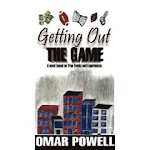Check out these informative articles by
Jessica McElrath (About.com):Jackie Robinson
Dates: January 31, 1919 - October 24, 1972
Occupation: baseball player
In a time when baseball was ruled by a strict color line, Jackie Robinson bravely agreed to be the first to integrate the major leagues. Although he faced hostility from white fans, baseball players, and even teammates, Robinson never buckled under the pressure. For nearly ten years he played for the Brooklyn Dodgers, and when he finally retired, he refused to remain silent on the issue of civil rights. Until the end of his life, Jackie Robinson never gave up his dream of equality for blacks.
zSB(3,3)
Jackie Robinson’s Early Years Jack (John) Roosevelt Robinson was born on January 31, 1919 in Cairo, Georgia. In 1920, his family moved to Pasadena, California. After graduating from John Muir Technical High School, Robinson attended Pasadena Community College. He went on to transfer to the University of California, Los Angeles (UCLA) in 1940. While at UCLA, Robinson played baseball, football, basketball, and track.
In 1942, Robinson was drafted into the Army. He served in Kansas and Texas, and eventually became a second lieutenant. While serving in Fort Hood, Texas, Robinson refused to obey an order to move to the back of an army bus. Because this was a violation of Army regulations, a court martial heard the matter; Robinson was acquitted.
Robinson Plays in the Negro Leagues When Robinson left the Army in 1944, he wanted to play baseball. At the time, baseball teams were segregated, and had been since 1887. Therefore, African American baseball players played in Latin America and in the Negro Leagues. Not unlike other African American players, Robinson also joined the Negro Leagues. He began playing for the Kansas City Monarchs.
Robinson is Recruited to the Minor Leagues Robinson's career in the Negro Leagues was short. In 1945, Branch Rickey, the manager of the Brooklyn Dodgers, requested a meeting with Robinson. Rickey wanted to integrate the major leagues and was looking for a player who could withstand the hostility that would come. After determining that Robinson was the perfect candidate, he asked him to first play for the minor league team, the Montreal Royals. On October 23, 1945, it became official when Robinson signed a contract with the team.
Robinson Integrates Major League Baseball Although Robinson had a successful year with the Royals, he was close to having a nervous breakdown by the end of the season. Notwithstanding his nerves, Robinson’s time with the Montreal Royals led to his April 1947 signing with the Dodgers. As expected, his entrance into the major leagues was not without controversy. Some white fans were hostile, while others were enthusiastic. Regardless of the reaction, Robinson excelled on the team. For the first few years he did not respond to the insults, but he began speaking out against racism in 1949. He attacked the Jim Crow laws in the South and spoke out in support of the desegregation of Southern hotels and ballparks.
Robinson’s Awards In 1947, The Sporting News, which had initially been opposed to the integration of the major leagues, awarded him its first Rookie of the Year Award. Robinson was also the recipient of numerous other awards and honors; in 1949, he was also awarded the National League’s Most Valuable Player, he received the Spingarn Medal in 1956, and he was inducted into the National Baseball Hall of Fame in 1962.
Robinson Supports the Fight for Civil Rights In 1956, Robinson retired. With his newfound freedom to speak out on behalf of African Americans, Robinson did not shy away from the public spotlight. He supported integration, was an active member of the
National Association for the Advancement of Colored People (NAACP), and he was a participant in the
March on Washington for Jobs and Freedom in 1963.
In addition to his activism, Robinson served as vice-president of personnel at Chock Full O' Nuts from 1957 to 1964. Robinson died of a heart attack in Stamford, Connecticut on October 24, 1972.
..........................................................................................................................................................................
Muhammand Ali
World Heavyweight Champion
Dates: January 17, 1942 -
Occupation: boxer
Muhammad Ali’s Early Life Muhammad Ali was born Cassius Marcellus Clay, Jr. to Cassius Marcellus Clay, Sr. and Odessa (Grady) Clay on January 17, 1942 in Louisville, Kentucky. Clay’s father worked painting billboards and signs and his mother worked as a domestic. Clay began boxing at the age of twelve, under the direction of Joe Martin. He began fighting in the amateur ranks. In the 1960 Olympic Games in Rome, he won a gold medal in the 175-pound division.
Muhammad Ali’s Professional Career
After the Olympics, Clay emerged in the professional league under the sponsorship of the Louisville Sponsoring Group. In October 1960, in his first professional heavyweight fight against Tunney Hunsaker, he won.
zSB(3,3)
After winning his next eighteen fights, fifteen by knockout, Clay was scheduled to fight the heavyweight champion Sonny Liston on February 25, 1964 in Miami Beach, Florida.
Clay was the considered the underdog to Liston who had knocked out his last three challengers in the first round. Before the fight, as Clay was known to do, he verbally attacked Liston and boasted that he would win. To the shock of the boxing world, Clay’s prediction came true. He defeated Liston.
Two days after the fight, Clay announced that he was converting to the Nation of Islam. On March 6, 1964, he changed his name to Muhammad Ali, which was the name given him by Elijah Muhammad. This was so controversial that during the 1960s, the New York Times and several other papers refused to acknowledge his new name when writing about him.
Ali fought a rematch with Liston on May 25, 1965. Ali knocked out Liston in the first round. Over the next two years, Ali defended his title and won against Floyd Patterson, George Chuvalo, Henry Cooper, Brian London, Karl Mildenberger, Cleveland Williams, Ernie Terrell, and Zora Folley.
Muhammad Ali’s Heavyweight Title is Stripped
On April 28, 1967, Ali made another controversial decision. When drafted in the U.S. Army during the war in Vietnam, he refused to go. For Ali, his opposition stemmed from more than just his belief that the war was immoral. He believed that since blacks did not experience equality at home, for them to serve in the war was a perversion of justice.
Initially, Ali was granted conscientious objector status, but after he stated that he was not against all wars and would participate in an Islamic holy war, he no longer qualified. He was fined ten thousand dollars, sentenced to five years in prison, and his heavyweight title and license to box was taken away. Four years later, his conviction was overturned by the U.S. Supreme court because of procedural grounds.
Ali Resumes His Professional Boxing Career
Ali returned to professional boxing in October 1970. Although his skills had eroded and he was less agile than before, he was victorious over Jerry Quarry and Oscar Bonavena. The challenge came when he fought Joe Frazier in the match called the “Fight of the Century. On March 8, 1971, Ali lost to Frazier. In a second match with Frazier, he won.
After years of working his way closer to the heavyweight title, on October 30, 1974, Ali fought heavyweight champion, George Foreman. The fight took place in Kinshasa, Zaire (now called the Democratic Republic of the Congo) and it was referred to as the “Rumble in the Jungle.” Ali was the favorite for the people of Zaire and Foreman was considered the American. In the eighth round, Ali knocked out Foreman. He regained the heavyweight title for a second time.
Before retirement, Ali had a few other notable fights. He fought a third match against Frazier. Called the “Thrilla in Manila,” the fight took place on October 1, 1975 in Manila, Philippines. Ali celebrated another victory over Frazier. On February 15, 1978, he lost his title to Olympic gold medallist, Leon Spinks. Less than a year later, he defeated Spinks, and for the third time he held the heavyweight title.
Muhammad Ali Retires
Ali retired in 1979, but returned to the ring in 1980 to fight Larry Holmes. His skills had substantially diminished and he suffered the worst loss of his career. He returned for his last fight in 1981 against Trevor Berbick. While not as brutal as his prior fight, he lost again.
In the late 1980s, Ali began suffering from Parkinson’s disease. Despite this hurdle, Ali remained active. He was the spokesperson for Operation USA in Rwanda in 1996, he formed the Muhammad Ali Community and Economic Development Corporation in Chicago, Illinois, and in 1996 he lit the opening flame at the Olympic Games in Atlanta.
..........................................................................................................................................................................
Jesse Owens
Dates: September 12, 1913 - March 31, 1980
Occupation: track and field athlete, Olympic medalist
Frail and often sickly as a child, who would have guessed that Jesse Owens would go on to achieve the status of an Olympic medalist. With Hitler in power, the 1936 Olympics in Berlin, Germany was marred by Aryan racism. Despite the pressure to perform, Owens went on to win four gold medals and set a new world record.
zSB(3,3)
Jesse Owens’ Childhood On September 12, 1913, James Cleveland Owens, later known as Jesse Owens, was born in Danville, Alabama, the seventh of eleven children. His father was a sharecropper, and with eleven children, it often meant that there was not enough food for all them. As a result, Owens was often sick.
With such grave financial prospects, when Owens was nine years old, his parents sold the family mule and moved to Cleveland, Ohio. It was in Cleveland that Owens became known as Jesse. When Owens started school, a teacher misunderstood his nickname J.C. and called him Jesse instead.
Owens Becomes a Track Star While at Fairview Junior High, track coach Charles Riley recognized Owens’ talent after he saw him sprint down a street. Riley was quick to recruit Owens, and began coaching him. With Riley still as his coach in high school, during his senior year he broke the world records for the 100 and 200-yard dashes and for the broad jump at the state scholastic meet.
After high school many colleges tried to recruit Owens, but he chose Ohio State University. In 1935, at the Big Ten Track and Field Championship, Owens set new world records; he tied the world record for the 100-yard dash and broke world records for the long jump, the 220-yard dash, and the 220-yard hurdles. A year later, Owens made the U.S. Olympic team.
Owens Competes at the Berlin Olympics At the 1936 Olympics in Berlin, Germany, Hitler was in power and by then his racist philosophy of Aryan superiority was prevalent. Nevertheless, despite the tension, Owens won gold medals in the 100 and 200-meter sprint, the 400-meter relay, and the broad jump, setting a new world record of 25 feet, 10¼ inches.
Owens’ Career after the Olympics Upon his return to the United States, Owens was disappointed with the continuing discrimination experienced by blacks. To make matters worse, Owens had trouble finding work. He decided to turn professional, and began engaging in races against a horse, a car, and other nonhuman opponents. Professional racing, however, failed to materialize financially. In the 1940s, he pursued work on the lecture circuit, which proved to be more lucrative.
In 1972, while still working on the public speaking circuit, Owens moved to Phoenix, Arizona. He became a philanthropist. In Owens’ name and with his financial support, the Jesse Owens Memorial Medical Center and the Jesse Owens Memorial Track Club was established. He also served on the boards of the National Council of Christians and Jews and the Boy Scouts of America. Owens died on March 31, 1980 in a Phoenix hospital.











